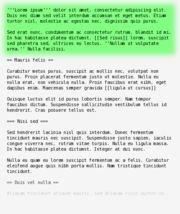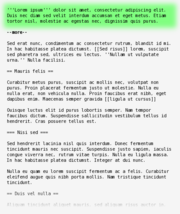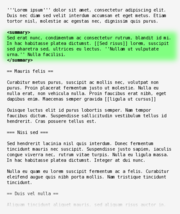Справка:Writing a wikilog article
| User Manual |
|
In order to create a new wikilog article, a new wiki page must be created as a subpage of the wikilog page. The wikilog article title is the subpage part of the page title. For example, a wikilog article "The brown fox" in the "Blog:General Rants" wikilog must have the full page title "Blog:General Rants/The brown fox".
The user can either create the page with the title directly, or use the wikilog content action tab from the main wikilog page. In the later case, the user should type the new article title in the "Create new wikilog article" box and press "Create" to be redirected to the edit page of the new article with the correct full title.
At the edit page, the user writes the contents of the wikilog article like any other wiki page. The article stays in "draft" state and won't show in listings until it is ready for publication. While in draft state, authors must use the wikilog content action tab to access the article, or directly via its URL.
Signing and publishing
In order for the article to show in the wikilog listing, it must be signed and published. The article is assigned an author and a date when published. In the most common usage, this can be achieved by simply adding four consecutive tildes ("~~~~") to the article text, preferably at its end near the other metadata like categores, interwiki links, tags, etc. This sequence of tildes are called "signature", and adding it to a piece of wikitext in MediaWiki is commonly referred as "to sign" the text. In wikilog context, this means "to sign and publish" the article. The edit toolbar provides a button for signing that can be used to insert this sequence in the text.
When the article is saved, the tilde sequence is replaced by a special markup that sets the article publication date and adds the current editor as an author. Other sequences, from 3 to 5 consecutive tildes, are also recognized by Wikilog, with different meanings:
| Function | Wiki markup | Wikilog meaning | Replaced by |
|---|---|---|---|
| Signature alone | ~~~ |
Add the current editor as an author of the wikilog article, without publishing the article. |
{{wl-author: user name }}
|
| Signature plus timestamp | ~~~~ |
Add the current editor as an author and immediately publish the article. |
{{wl-publish: current time | user name }}
|
| Timestamp alone | ~~~~~ |
Immediately publish the article, but don't set any new author. |
{{wl-publish: current time }}
|
It may be noticed that the meanings of these markups are very intuitive when compared to the standard signatures.
Article summary
Wikilog articles, like any wiki page, can be very long. Wikilog pages list several articles at a time, and visitors may not be interested in reading entire articles when casually visiting the wikilog. Instead, wikilog pages shows only article summaries. Visitors click the article title or a "continue reading..." link to read the full article in its own page.
Summaries are either inferred automatically by Wikilog or defined explicitly by article authors.
Automatic summaries are used when no indication is explicitly provided. The algorithm is very simple: all the text from the beginning up to the first page heading is used as a summary of the article. In other words, the zeroth section of the page is its summary. This usually leads to good results: short articles usually have only a single section and no headings, so the whole article is its own summary; long articles, on the other hand, are usually divided in many sections, and only the leading section is used. But this implementation will give really bad results for a long article with no headings. In this case, a summary should be manually defined.
Manual summaries can be defined by using specific delimiters in the article text. There are two methods to define a manual summary for an article.
The first method is to place the --more-- delimiter in a line by itself. Everything before the delimiter is used as the article summary. The full article includes all the text before the delimiter (the summary) and the text after the delimiter. The delimiter itself is invisible. Due to the nature of this method, only the beginning of the article can be used as a summary.
summary text --more-- rest of article text
The second method is to surround part of the article text with the <summary>...</summary> markup. Only the text between these tags will be used as the summary of the article. The summary is also normally shown as part of the article text.
It is possible to define a summary that will only be used in wikilog listings, and not appear in the article page itself. This can be useful in order to display a slightly different text in wikilog listings, perhaps with different formatting or with a thumbnail of an image of the article. In this case, the hidden parameter must be passed in the opening summary tag. The text between the summary tags will not appear in the article page.
The general syntax of the summary tag is:
<summary [ hidden ]> summary text </summary>
| This page is part of the Wikilog extension user manual, which is licensed under a Creative Commons Attribution-Share Alike 3.0 Unported License. The original text is available at the extension site. |



